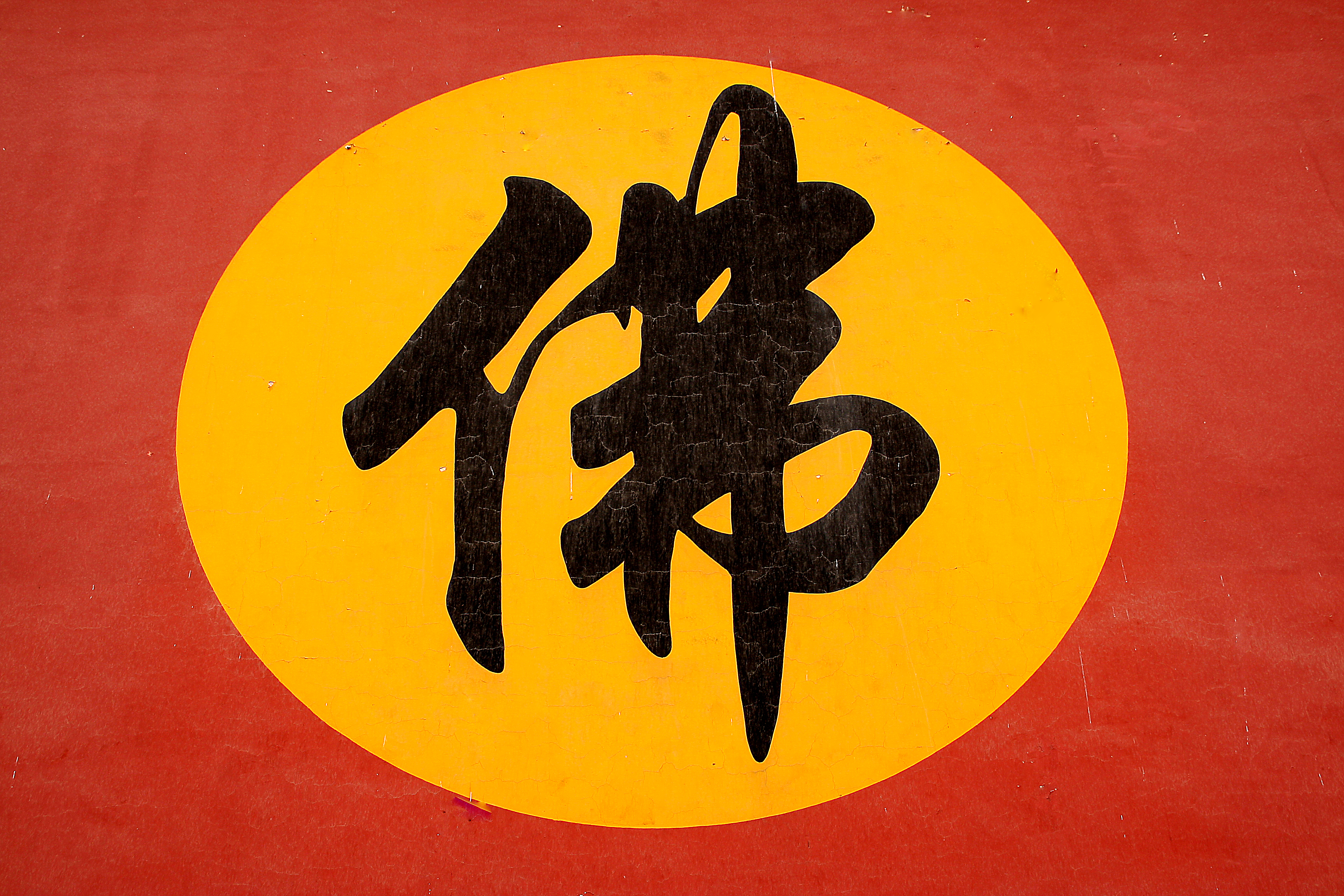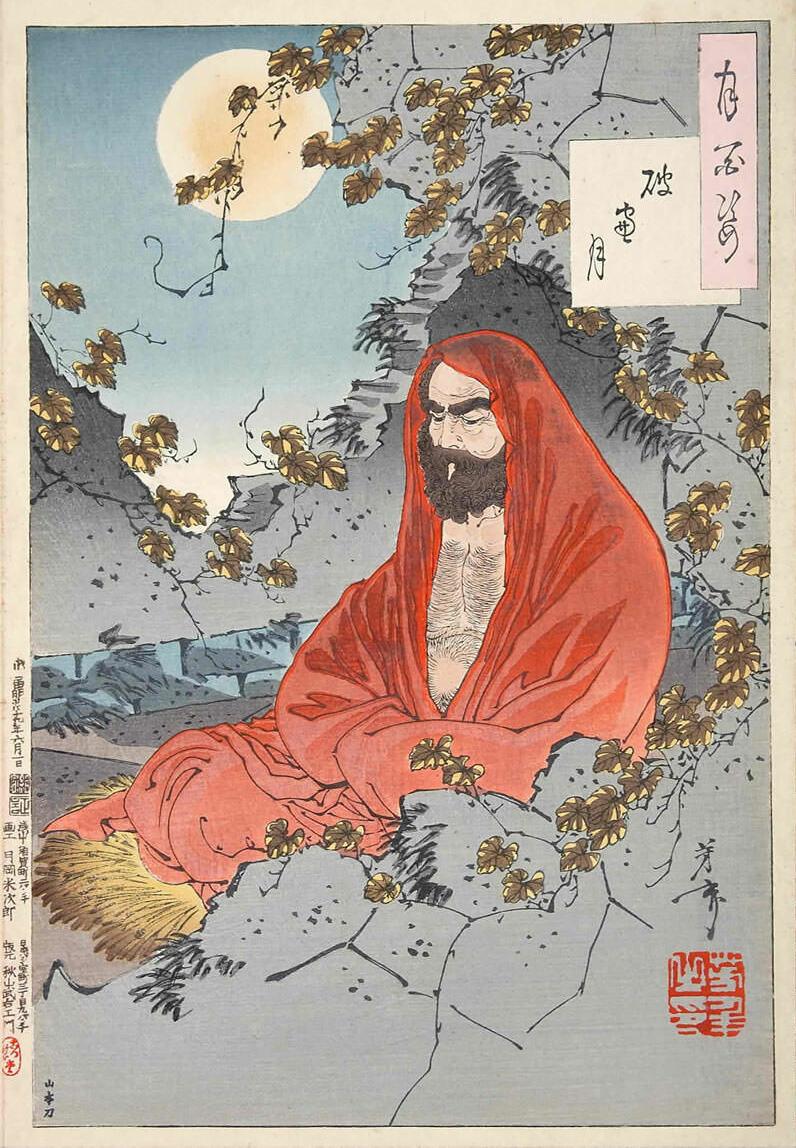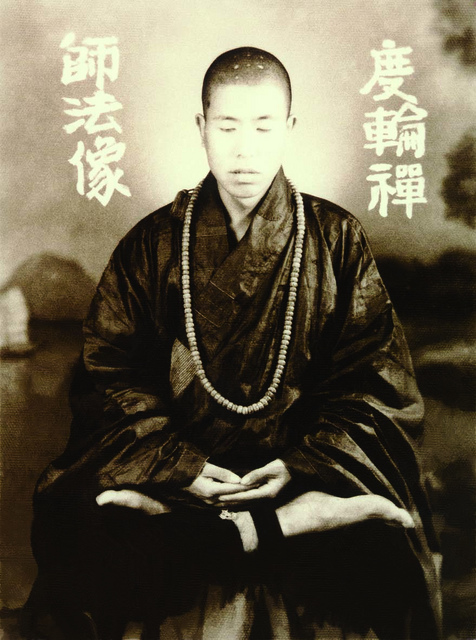|
Zen
Zen (; from Chinese: ''Chán''; in Korean: ''Sŏn'', and Vietnamese: ''Thiền'') is a Mahayana Buddhist tradition that developed in China during the Tang dynasty by blending Indian Mahayana Buddhism, particularly Yogacara and Madhyamaka philosophies, with Chinese Taoist thought, especially Xuanxue, Neo-Daoist. Zen originated as the Chan Buddhism, Chan School (禪宗, ''chánzōng'', 'meditation school') or the Buddha-nature, Buddha-mind school (佛心宗'', fóxīnzōng''), and later developed into various sub-schools and branches. Chan is traditionally believed to have been brought to China by the semi-legendary figure Bodhidharma, an Indian (or Central Asian) monk who is said to have introduced dhyana teachings to China. From China, Chán spread south to Vietnam and became Thiền, Vietnamese Thiền, northeast to Korea to become Korean Seon, Seon Buddhism, and east to Japan, becoming Japanese Zen. Zen emphasizes Buddhist meditation, meditation practice, direct insight int ... [...More Info...] [...Related Items...] OR: [Wikipedia] [Google] [Baidu] |
Japanese Zen
:''See also Zen for an overview of Zen, Chan Buddhism for the Chinese origins, and Sōtō, Rinzai school, Rinzai and Ōbaku for the three main schools of Zen in Japan'' Japanese Zen refers to the Japanese forms of Zen, Zen Buddhism, an originally Buddhism in China, Chinese Mahāyāna school of Buddhism that strongly emphasizes Dhyāna in Buddhism, dhyāna, the Meditation, meditative training of awareness and equanimity. This practice, according to Zen proponents, gives insight into one's Buddha-nature, true nature, or the Śūnyatā, emptiness of inherent existence, which opens the way to a enlightenment in Buddhism, liberated way of living. History Origins According to tradition, Zen originated in ancient India, when Gautama Buddha Flower Sermon, held up a flower and Mahākāśyapa smiled. With this smile he showed that he had understood the wordless essence of the dharma#Buddhism, dharma. This way the dharma was transmitted to Mahākāśyapa, the second patriarch of Z ... [...More Info...] [...Related Items...] OR: [Wikipedia] [Google] [Baidu] |
Kenshō
Kenshō (Rōmaji; Japanese and classical Chinese: 見性, Pinyin: ''jianxing'', Sanskrit: dṛṣṭi- svabhāva) is an East Asian Buddhist term from the Chan / Zen tradition which means "seeing" or "perceiving" ( 見) "nature" or "essence" ( 性), or 'true face'. It is usually translated as "seeing one's ruenature," with "nature" referring to buddha-nature, ultimate reality, the Dharmadhatu. The term appears in one of the classic slogans which define Chan Buddhism: to see oneʼs own nature and accomplish Buddhahood (見性成佛). Kenshō is an ''initial'' insight or sudden awakening, not full Buddhahood. It is to be followed by further training which deepens this insight, allows one to learn to express it in daily life and gradually removes the remaining defilements. The Japanese term kenshō is often used interchangeably with satori, which is derived from the verb satoru, and means "comprehension; understanding". Terminology The Chinese Buddhist term ''jianxing'' () ... [...More Info...] [...Related Items...] OR: [Wikipedia] [Google] [Baidu] |
Chan Buddhism
Chan (; of ), from Sanskrit '' dhyāna'' (meaning " meditation" or "meditative state"), is a Chinese school of Mahāyāna Buddhism. It developed in China from the 6th century CE onwards, becoming especially popular during the Tang and Song dynasties. Chan is the originating tradition of Zen Buddhism (the Japanese pronunciation of the same character, which is the most commonly used English name for the school). Chan Buddhism spread from China south to Vietnam as Thiền and north to Korea as Seon, and, in the 13th century, east to Japan as Japanese Zen. History The historical records required for a complete, accurate account of early Chan history no longer exist. Periodisation The history of Chan in China can be divided into several periods. Zen, as we know it today, is the result of a long history, with many changes and contingent factors. Each period had different types of Zen, some of which remained influential, while others vanished. Andy Ferguson distinguishes thr ... [...More Info...] [...Related Items...] OR: [Wikipedia] [Google] [Baidu] |
Chán
Chan (; of ), from Sanskrit '' dhyāna'' (meaning "meditation" or "meditative state"), is a Chinese school of Mahāyāna Buddhism. It developed in China from the 6th century CE onwards, becoming especially popular during the Tang and Song dynasties. Chan is the originating tradition of Zen Buddhism (the Japanese pronunciation of the same character, which is the most commonly used English name for the school). Chan Buddhism spread from China south to Vietnam as Thiền and north to Korea as Seon, and, in the 13th century, east to Japan as Japanese Zen. History The historical records required for a complete, accurate account of early Chan history no longer exist. Periodisation The history of Chan in China can be divided into several periods. Zen, as we know it today, is the result of a long history, with many changes and contingent factors. Each period had different types of Zen, some of which remained influential, while others vanished. Andy Ferguson distinguishes thre ... [...More Info...] [...Related Items...] OR: [Wikipedia] [Google] [Baidu] |
Bodhidharma
Bodhidharma was a semi-legendary Bhikkhu, Buddhist monk who lived during the 5th or 6th century CE. He is traditionally credited as the transmitter of Chan Buddhism to China, and is regarded as its first Chinese Lineage (Buddhism), patriarch. He is also popularly regarded as the founder of Shaolin kung fu, an idea popularized in the 20th century, but based on the 17th century Yijin Jing and the Daoist association of ''daoyin'' gymnastics with Bodhidharma. Little contemporary biographical information on Bodhidharma is extant, and subsequent accounts became layered with legend and unreliable details. According to the principal Chinese sources, Bodhidharma came from the Western Regions, which typically refers to Central Asia but can also include the Indian subcontinent, and is described as either a "Persians, Persian Central Asian" or a "South Indian [...] the third son of a great Indian king." Aside from the Chinese accounts, several popular traditions also exist regarding Bodhi ... [...More Info...] [...Related Items...] OR: [Wikipedia] [Google] [Baidu] |
Zazen
''Zazen'' is a meditative discipline that is typically the primary practice of the Zen Buddhist tradition. The generalized Japanese term for meditation is 瞑想 (''meisō''); however, ''zazen'' has been used informally to include all forms of seated Buddhist meditation. The term ''zuòchán'' can be found in early Chinese Buddhist sources, such as the Dhyāna sutras. For example, the famous translator Kumārajīva (344–413) translated a work termed ''Zuòchán sān mēi jīng'' (''A'' ''Manual on the Samādhi of Sitting Meditation'') and the Chinese Tiantai master Zhiyi (538–597 CE) wrote some very influential works on sitting meditation. The meaning and method of zazen varies from school to school, but in general it is a quiet type of Buddhist meditation done in a sitting posture like the lotus position. The practice can be done with various methods, such as following the breath (anapanasati), mentally repeating a phrase (which could be a koan, a mantra, a huato ... [...More Info...] [...Related Items...] OR: [Wikipedia] [Google] [Baidu] |
Dhyāna In Buddhism
In the oldest texts of Buddhism, ''dhyāna'' () or ''jhāna'' () is a component of the training of the mind (''bhavana''), commonly translated as Buddhist meditation, meditation, to withdraw the mind from the automatic responses to sense-impressions and "burn up" the Kleshas (Buddhism), defilements, leading to a "state of perfect equanimity and awareness (''Upekṣā, upekkhā-Sati (Buddhism), sati-Purity in Buddhism, parisuddhi'')." ''Dhyāna'' may have been the core practice of pre-sectarian Buddhism, in combination with several related practices which together lead to perfected mindfulness and detachment. In the later commentarial tradition, which has survived in present-day Theravada, Theravāda, ''dhyāna'' is equated with "concentration", a state of one-pointed absorption in which there is a diminished awareness of the surroundings. In the contemporary Theravāda-based Vipassana movement, this absorbed state of mind is regarded as unnecessary and even non-beneficial for t ... [...More Info...] [...Related Items...] OR: [Wikipedia] [Google] [Baidu] |
Buddha-nature
In Buddhist philosophy and soteriology, Buddha-nature ( Chinese: , Japanese: , , Sanskrit: ) is the innate potential for all sentient beings to become a Buddha or the fact that all sentient beings already have a pure Buddha-essence within themselves.Heng-Ching ShihThe Significance Of 'Tathagatagarbha' – A Positive Expression Of 'Sunyata'/ref> "Buddha-nature" is the common English translation for several related Mahāyāna Buddhism, Buddhist terms, most notably ''tathāgatagarbha'' and ''buddhadhātu'', but also ''sugatagarbha,'' and ''buddhagarbha''. ''Tathāgatagarbha'' can mean "the womb" or "embryo" (''garbha'') of the "thus-gone one" (''Tathagata, tathāgata''), and can also mean "containing a ''tathāgata''"''. Buddhadhātu'' can mean "buddha-element", "buddha-realm", or "buddha-substrate". Buddha-nature has a wide range of (sometimes conflicting) meanings in Indian Buddhism and later in East Asian Buddhism, East Asian and Tibetan Buddhism, Tibetan Buddhist literatur ... [...More Info...] [...Related Items...] OR: [Wikipedia] [Google] [Baidu] |
Rōshi
(Japanese language, Japanese: "old teacher"; "old master") is a title in Zen Buddhism with different usages depending on sect and country. In Rinzai Zen, the term is reserved only for individuals who have received ''inka shōmei'', meaning they have completed the entire ''kōan'' curriculum; this amounts to a total of fewer than 100 people at any given time. In Sōtō Zen and Sanbo Kyodan it is used more loosely. This is especially the case in the United States and Europe, where almost any teacher who has received dharma transmission might be called rōshi, or even use it to refer to themselves, a practice unheard of in Japan. Etymology The Japanese ''rōshi'' is a translation of the more antiquated Chinese ''Laozi'' (Wade-Giles; ''Lao Tzu'') meaning 'Old Master' and connoting the archetype of a wise old man. The modern Chinese 老師/老师 (''Chinese'' ) is a common word for teacher or professor without the religious or spiritual connotation of ''rōshi''. Chinese Chan Buddhi ... [...More Info...] [...Related Items...] OR: [Wikipedia] [Google] [Baidu] |
Buddhist Meditation
Buddhist meditation is the practice of meditation in Buddhism. The closest words for meditation in the classical languages of Buddhism are ''bhavana, bhāvanā'' ("mental development") and ''Dhyāna in Buddhism, jhāna/dhyāna'' (a state of meditative absorption resulting in a calm and luminous mind). Buddhists pursue meditation as part of the path toward Moksha, liberation from defilements (''Kleshas (Buddhism), kleshas'') and clinging and craving (''upādāna''), also called Bodhi, awakening, which results in the attainment of nirvana. The Indian Schools of Buddhism, Buddhist schools relied on numerous meditation techniques to attain meditative absorption, some of which remain influential in certain modern schools of Buddhism. Classic Buddhist meditations include ''anapanasati'' (mindfulness of breathing), ''Patikulamanasikara, asubha bhavana'' ("reflections on repulsiveness");Deleanu, Florin (1992)Mindfulness of Breathing in the Dhyāna Sūtras Transactions of the Internatio ... [...More Info...] [...Related Items...] OR: [Wikipedia] [Google] [Baidu] |
Korean Seon
Seon or Sŏn Buddhism (; ) is the Korean name for Chan Buddhism, a branch of Mahāyāna Buddhism commonly known in English as Zen Buddhism. Seon is the Sino-Korean pronunciation of Chan, () an abbreviation of 禪那 (''chánnà''), which is a Chinese transliteration of the Sanskrit word of ''dhyāna'' ("meditation"). Seon Buddhism, represented chiefly by the Jogye and Taego orders, is the most common type of Buddhism found in Korea. A main characteristic of Seon Buddhism is the use of the method of meditation, Ganhwa Seon. A Korean monk, Jinul accepted partially a meditative method of Chan Buddhism in 1205. In Chan Buddhism, ''hwadu'' () is a delivery of realising a natural state of the Awakening. Jinul addressed a doctrine of Sagyo Yiepseon () that monks should live an inborn life after learning and forgetting all creeds and theories. Within the doctrine of Jinul, ''hwadu'' is the witnessing of truthful meaning in everyday life. History During the Goryeo dynasty Jinu ... [...More Info...] [...Related Items...] OR: [Wikipedia] [Google] [Baidu] |
Thiền
Thiền Buddhism (, , ) is the name for the Vietnamese school of Zen Buddhism. Thiền is the Sino-Vietnamese pronunciation of the Middle Chinese word 禪 (''chán''), an abbreviation of 禪那 (''chánnà''; thiền na), which is a transliteration of the Sanskrit word ''dhyāna'' ("meditation"). History Early period Chinese Chan Buddhism was introduced during the early Chinese domination of Vietnam, 111 BCE to 939 CE, which also accommodated local animism and Cham influences.Johnston, William M. (editor), ''Encyclopedia of Monasticism,'' p. 276. According to traditional accounts, in 580, an Indian monk named Vinītaruci () who is considered the founder of Thiền, traveled to Vietnam after completing his studies with Sengcan, the third Patriarch of Chan. However, Chan was already present in the country before his arrival. "Thiền Buddhism was already established in Vietnam before Vinītaruci's arrival, for Phap Hien studied under and was ... After Vinītaruci's death, ... [...More Info...] [...Related Items...] OR: [Wikipedia] [Google] [Baidu] |








